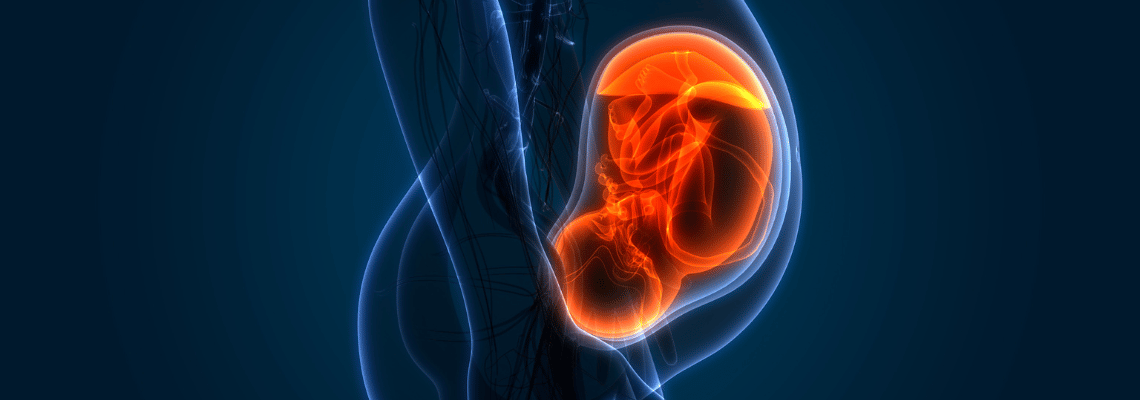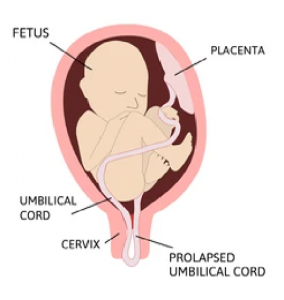
Among the many situationally specific events that can take place during pregnancy, one rare, emergency occurrence is known as umbilical cord prolapse. Occurring in less than one percent, or approximately one in every 300 births, this condition occurs when the umbilical cord enters the mother’s vagina, dropping between the fetal presenting part and the cervix, before birth.
As the baby’s lifeline to the mother, the umbilical cord transports nutrients to the baby and also carries away the baby’s waste products. This rare but serious complication is cause for concern when present as the occurrence can deprive the fetus of oxygen, and may even result in a stillbirth.
Causes of Umbilical Cord Prolapse
When the umbilical cord is too long, it is more likely to prolapse. The cord may be longer than average, or the baby may be positioned low in the uterus. That can cause the cord to fall through the cervix and into the birth canal ahead of the baby. In some cases, the umbilical cord may be long enough to wrap around the baby’s neck. If this happens, it is referred to as a nuchal cord. A nuchal cord can increase the risk of umbilical cord prolapse.
If the baby is in a breech position, in which their bottom or feet are down instead of their head, it can increase the risk of umbilical cord prolapse. That is because the baby’s head puts pressure on the cord, which can cause it to slip out of the uterus and into the birth canal. Breech babies are also more likely to have their cords wrapped around the body, increasing the risk of prolapse.
Cord prolapse is also more likely to occur if amniotic fluid leaks from the sac surrounding the baby. Should the amniotic sac ruptures before the baby is born, known as premature rupture of membranes or PROM, there’s a greater chance of cord prolapse because there’s nothing to support the cord once it drops into the vaginal canal. When this happens, it is highly critical to seek medical attention immediately, as cord prolapse can be fatal for the baby.
Complications That May Increase Your Risk of Cord Prolapse
The incompetent cervix is one of the most common causes. While it can occur in any pregnancy, it is more common in women who have had a previous cesarean delivery or are carrying twins or triplets. If you have an incompetent cervix, your doctor will likely recommend bed rest and close monitoring of your pregnancy. If the prolapse does occur, it is treated with an emergency cesarean delivery.
Placenta previa is when the placenta lies low in the uterus, near or over the cervical opening. That can cause the umbilical cord to drop into the birth canal, which may become compressed during labor.
When you have more than one baby, you are at increased risk because the extra weight of the baby can put pressure on the cord, causing it to slip through the opening in the uterus. If this happens during childbirth, it can be very dangerous for both mother and child. That’s why it is essential to be aware of the signs of umbilical cord prolapse and seek emergency medical attention if you think it may be happening. Some symptoms to look out for include a sudden change in fetal heart rate, cramping or contractions, and vaginal bleeding.
Polyhydramnios occurs when too much amniotic fluid surrounds the baby in the womb. That can place additional pressure on the cord and cause it to drop into the birth canal. If you are diagnosed with polyhydramnios, your healthcare provider will closely monitor you during pregnancy and may recommend an induction or a C-section to reduce the risk of cord prolapse.
 Signs, Symptoms and Treatment
Signs, Symptoms and Treatment
The most common symptom of umbilical cord prolapse is feeling the prolapsed cord in your vagina after your water has broken. One study estimates that 57 percent of prolapses occur within five minutes after the membrane ruptures, and 67 percent occur within one hour of the rupture. Other signs and symptoms may include contractions, abdominal pain, fetal distress, vaginal bleeding and a change in baby’s heart rate. Diagnosis of umbilical cord prolapse is done so by seeing or palpating the prolapsed cord on a pelvic exam. If it is not treated quickly, it can lead to serious complications for both mother and child. With prompt medical treatment, however, most women go on to have healthy pregnancies and babies.
If and when umbilical cord prolapse is diagnosed, the most important thing to do is deliver the baby as soon as possible. That is done via C-section or induction. In some cases, it may be possible to reposition the baby, so the cord is no longer compressed, however, this is only possible if the umbilical cord is not completely prolapsed and the baby’s head isn’t engaged in the birth canal.
Though a scary concern to think about, umbilical cord prolapse is relatively rare. However, if it does occur, quick outreach to a doctor and fast prognosis is generally good with early detection and can be treated promptly. Expectant mothers should be aware of the symptoms and seek medical attention immediately if they occur.


